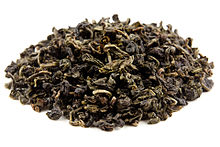Oolong
| German | Oolong tea |
|---|---|
| English | Oolong tea |
| Chinese |
乌龙茶 , wūlóngchá
青茶 , qīngchá |
| Water temperature | 75 ° C to 90 ° C |
| Brewing time | a matter of taste
1-5 minutes |
Oolong ( Chinese 烏龍茶 / 乌龙茶 , Pinyin wūlóngchá - "black dragon tea", also: 青茶 , qīngchá - "green-blue tea") is a traditional Chinese type of tea . The oxidation level is between that of green and black tea .
Origin and meaning of the name
The term Oolong ( 烏龍 / 乌龙 , wūlóng ) means black dragon . Various legends describe the origin of this name. One of these legends says that the owner of a tea plantation was chased away by a black dragon while drying the tea leaves; when he carefully stepped back a few days later, the leaves were oxidized in the sun and made a delightful drink.
The " four famous tea bushes " of the Wuyi Mountains in the northwest of the Chinese province of Fujian are considered the oldest known tea bushes from whose leaves Oolong tea is made .
Manufacturing
For oolong tea, the tea leaves must first begin to wither in the sun after being picked. After that, they are stored in a room to rest; then the oxidation takes place. The leaves are gently rubbed and shaken again and again so that the sap that comes out reacts with the oxygen in the air; but not as long as black tea. The oxidation was stopped in the traditional way by heating in iron pans. Depending on the duration of the oxidation, the oolong treated in this way tends to taste more like green or black tea.
Properties, infusion
Tea connoisseurs classify tea according to its aroma (fragrant, floral), taste and aftertaste. The best oolong teas are the Oriental Beauty ( 東方 美人 / 东方 美人 , Dōngfāng Měirén ) from Taiwan , from the traditional growing areas in Hsinchu , Miaoli and Pinglin , the Dongding Oolong ( 凍 頂 烏龍 / 冻 顶 乌龙 , Dòngdǐng Wūlóng ), after the mountain Dongding ( 凍 頂 山 / 冻 顶 山 , Dòngdǐng Shān ) in the district of Nantou (especially Lugu municipality ) in Taiwan and the Tieguanyin ( 鐵 觀音 / 铁 观音 , Tiěguānyīn ) from the province of Fujian in China . The Phoenix Dancong ( 鳳凰 單 叢 / 凤凰 单 丛 , Fènghuáng Dāncōng ) from Chao'an in Guangdong is one of the best oolong gardens.
For some years now, Oolong teas have also been produced in India , Malaysia , Vietnam , Thailand , Malawi and Kenya , some of which have different taste characteristics.
Oolong tea can be infused several times. Small teapots made of unglazed clay such as a Yixing teapot are traditionally used for this ; Oolong tea is usually poured using the Gong-Fu method . The individual infusions are named one after the other as:
- Good smell tea;
- Good taste tea;
- Long Friendship Tea.
sorts
Well-known oolong teas from China are:
-
武夷 岩茶 - "wǔ yí yán chá" - rock tea from the Wuyi Mountains in the northwest of Fujian Province . Which includes:
- 大 紅袍 , dà hóng páo - "Big red robe" - Da Hong Pao , more strongly fermented oolong.
- 白 雞冠 / 白 , bái jī guān - "White cockscomb " - Bai Ji Guan , a light oolong.
- 水 金龜 , shuǐ jīn guī - "Golden Sea Turtle" - Shui Jin Gui .
- 铁 罗汉 , tiě luó hàn - "Iron warrior monk or Iron Arhat " - Tie Luo Han
- 安溪鐵觀音 / 安溪铁观音 , tiě guānyīn - "Iron Guanyin " - Tie Guanyin from Anxi County in the south of Fujian.
A little known specialty in Europe is stored oolong. Similar to pu-erh teas , certain, high-quality oolongs gain in taste and quality over time under ideal storage conditions.
Web links
Individual evidence
- ↑ How To Brew Oolong Tea. Accessed January 21, 2020 (English).
- ↑ Term “Oolongcha (烏龍茶 / 乌龙茶)”, Chinese / German: [1] on dict.leo.org, accessed on January 21, 2018 - Online
- ↑ a b c d Oolong Tea. adagio teas, accessed May 1, 2016 .
- ↑ Term "Oolong (烏龍 / 乌龙)", Chinese: [2] on zdic.net, accessed on January 21, 2018 - online
- ↑ a b Chen Zongmou: Zhongguo cha jing . Shanghai 1992, ISBN 7-80511-499-4 .
- ^ Babette Donaldson: The Everything Healthy Tea Book . Discover the healing benefits of tea . Adams, Avon 2014, ISBN 978-1-4405-7459-7 .

